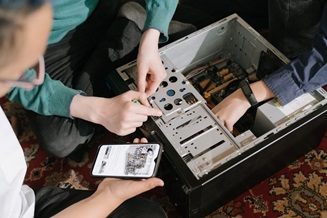
In today's tech-savvy world, building your own computer has become a and rewarding DIY project for many enthusiasts. Not only does it allow you to customize and tailor your system to your specific needs, but it also provides a deeper understanding of how computer components work together. In this article we will guide you through process of building your computer from start to finish.
-
Planning and Research:
Before diving into building your own computer, it's essential to plan and research your build carefully. Consider your budget, intended (gaming, content creation, office work, etc.), and desired specifications. Research compatible components, such as the motherboard, CPU, GPU, RAM, storage, power supply, and cooling system, to ensure they work seamlessly together. -
Choosing Components:
Select high-quality components from reputable brands that match your requirements and budget. Consider factors such as CPU performance, GPU capabilities, RAM capacity, storage type (SSD or HDD), case size, and power supply wattage. Ensure compatibility between components, such as CPU socket type with the motherboard, RAM speed with the motherboard's supported frequency, and GPU size with the case dimensions. -
Assembling the Computer:
Once you have gathered all the components, it's time to start assembling your computer. Begin by installing the CPU into the motherboard, followed by the RAM modules, GPU, and storage devices. Carefully connect all power cables, front panel connectors, and fans to the motherboard. Place the motherboard into the case, secure it with screws, and connect the necessary cables. -
Cable Management and Testing:
Proper cable management is essential for airflow and aesthetics inside your computer case. Organize cables neatly, secure them with ties or clips, and ensure they do not obstruct airflow or moving parts. Once everything is connected, power on the computer and enter the BIOS to verify that all components are detected correctly. Install the operating system of your choice and update drivers to ensure optimal performance. -
Customization and Personalization:
Building your own computer offers endless possibilities for customization and personalization. Consider adding LED lighting, custom cable extensions, additional cooling solutions, or case modifications to enhance the look and functionality of your system. Overclocking components, optimizing fan curves, and tweaking settings can further improve performance, but do so cautiously to avoid damage. -
Maintenance and Upgrades:
Regular maintenance, such as dusting components, monitoring temperatures, and updating software, is crucial for ensuring your computer operates smoothly. As technology evolves, you may consider upgrading individual components, such as the CPU, GPU, or storage, to keep your system up to date with the latest advancements.
Building your own computer is a fulfilling and educational experience that empowers you to create a personalized system tailored to your needs and preferences. By following this guide and taking your time with each step, you can embark on a rewarding journey of constructing a high-performance computer from scratch. Enjoy the process, learn along the way, and unleash the full potential of your custom-built PC.




:max_bytes(150000):strip_icc()/zayn-malik-yu-gi-oh-tout-083024-60229809bfa54abda8005e01879b47ae.jpg)














